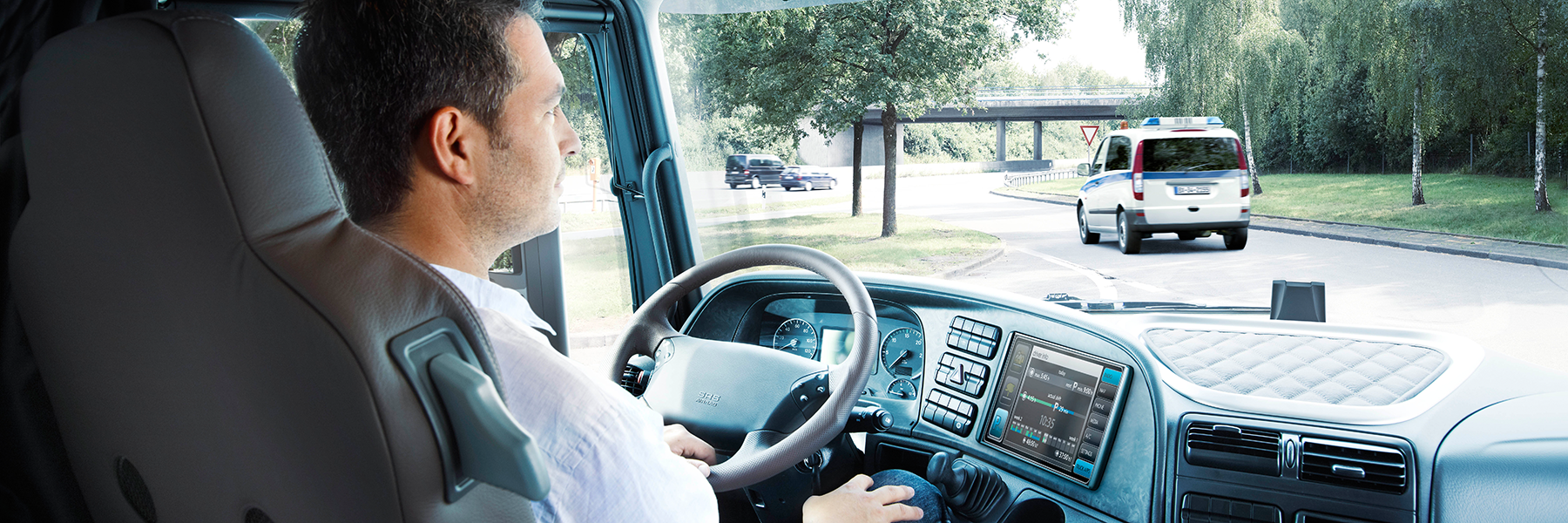Needless fines are equally annoying for driving personnel and fleet managers alike. From incorrect use of the tachograph to gaps in one’s knowledge of driving and rest times: The danger of making mistakes in one’s work routine is omnipresent. However, the problem is easy to avoid. The necessary knowledge protects against infringements of the law and saves money.
The top 5 causes of fines
The greatest potential for savings can naturally be found in those violations that occur most frequently – because all of them are expensive. These are mistakes in using the DTCO. Unlawful driving behaviour – such as exceeding the speed limit or driving too close to the vehicle in front – is not considered here. Below, you will find the five most frequent avoidable violations associated with tachographs.
1st place: Infringements of driving and rest times not only occur very frequently – but are also very costly for drivers and companies alike. This applies to daily driving and rest times just as much as to weekly driving and rest times. For example, if the break between driving times is reduced by more than 15 minutes the driver has to reckon with a fine of 60 euros for every started quarter of an hour, and the company with as much as 180 euros.
2nd place: No less exasperating are mistakes that can arise when activities that take place after the last time the driver card was removed are recorded manually. If these entries are interrupted then there will be a gap in the records, including the absence of country specifications. This results in fines of between 75 and 250 euros per day.
3rd place: The same applies to an incorrect setting of the time-group switch prior to departure, with the result that the departure check is not documented. In this case, the time at which work started cannot be determined.
4th place: If it is not possible to respect an obligatory interruption to the driving time then this must be precisely documented. The reasons for this may be, for example, a lengthy search for a parking place or a traffic jam. In such cases it is necessary to generate a daily report which must indicate the type of discrepancy and the reason for it. If all this is not documented then the missed driving time interruption is considered to be a punishable offence.
5th place: A more easily avoided fine can scarcely be imagined – and yet it happens over and over again: What we are talking about is printer paper for the tachograph. This is essential for the end-to-end documentation of the work shift in the cab. However, sufficient reserves are often not carried, usually for cost reasons. Nevertheless, it is obligatory to have a reserve of paper available at all times. The associated fine amounts to 75 euros per shift.
A one-off training in tachograph use is not enough
The cause of violations such as these is easy to identify: In most cases, it is simply down to a lack of knowledge. Ultimately, there are very few truck drivers who would willingly hand over a fine that could have been avoided by using the DTCO properly. However, the law does not ask all that much of transport companies: Anyone who has already been trained in using a DTCO usually only has to provide evidence of a yearly refresher course. And the decision who administers this is up to the fleet manager. This makes it rather unsurprising that, after a while, mistakes start to happen and result in costly fines.
It is therefore particularly advisable for the driving personnel to be instructed in the use of the DTCO in short intervals beyond the legal requirements (article 33 of Regulation (EU) No. 165/2014) – and that this training is provided by suitable instructors using professional equipment.
Knowledge direct from the manufacturer
To this end, Continental, as a manufacturer of DTCOs, has set up its own VDO Academy which offers a wide range of initial and further training options dealing with the use of digital tachographs. The offering ranges from classroom instruction via regional contact points through to the newly introduced online training events and webinars. The stated aim is to provide drivers and companies with the knowledge necessary for them to avoid fines and thereby ensure greater sustainability within the sector. This creates security for drivers and transport companies, says Marcello Lucarelli, European Head of the Commercial Vehicle Services business segment. This is why he considers the VDO Academy to be “helping the sector invest more in urgent and socially important topics such as recruiting and retaining drivers, vehicle safety and reducing CO2 emissions.”
Online training and webinars available now
To make this popular offering even more accessible – in particular for employees who cannot take part in on-site seminars at the VDO Academy – the VDO Academy also offers online seminars. In these, it is possible to perform obligatory training on-screen and also learn about other DTCO-related topics thanks to clearly presented graphical material and videos. Interactive, practical training activities guide participants through all the desired topics. “We are creating a virtual training space. Here, drivers and workshops alike learn how to handle the DTCO reliably within the framework of all the relevant EU regulations. And all this without having to commit to any fixed dates and times,” explains Volker Gut, the responsible Project Manager at Continental.
The convenient, practical path to the certificate – in 70 minutes
Just how this type of online training takes place can be seen through the example of “Practical training in the smart tachograph: DTCO 4.0”. The aim of the training is to instruct participants in this second-generation recording equipment in compliance with article 33 and then issue them with a corresponding certificate.
To this end, participants receive training on all the important settings, additional manual entries and new functions at realistic recording equipment – all simply at the click of a mouse. First of all, they must show their competence in eight areas, including, for example, “Additional manual entries”, “Entering the time group” or “New functions (ITS and DSRC interface, DNSS antenna)”. The participants are assisted by a speaker, immediate feedback on their input and numerous explanations. Once this learning and exercise phase has been completed successfully, participants can start a final test in which all the trained tasks must be completed without assistance. Students who pass the test can download a personalized certificate to complete the course, after approximately 70 minutes of training. If necessary, the program also saves intermediate statuses so that the instruction can be resumed on the next login.
Interested parties can register free of charge at www.vdo-academy.de. Here, they will be informed about the entire training offering on digital tachographs, and are able to book dates and make payments quickly and easily.








